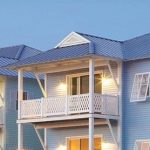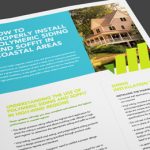In a hurricane, exterior cladding becomes the front line of defense against damage to the interior. If siding or soffit is ripped off your house, you may have more than exterior repairs, wind-driven rain may cause damages to the interior. To verify that vinyl siding can withstand a windstorm, manufacturers evaluate their products in controlled laboratory conditions, such as those required by ASTM D3679, the gold Standard Specification for Rigid Poly (Vinyl Chloride) (PVC) Siding. In addition to ASTM D3679, Florida’s 2017 building code includes state-specific testing, product approval and installation requirements that vary according to regional wind characteristics.
Laboratory assessments have led to improvements in the manufacture of vinyl siding for high wind environments and strict installation standards that have become code requirements. The 2018 International Building Code®(IBC®) and the International Residential Code® (IRC®) include updated and upgraded nailing standards to improve soffit performance.
The benchmark set for vinyl siding under current code standards requires siding to withstand wind pressures equivalent to 110 mph on a building up to 30′ in height, yet most vinyl siding can pass tests for much higher stresses, many times suitable for hurricane-prone areas. The trick is to read manufacturers specifications for siding designed for high winds if you live along the hurricane coast. Some vinyl siding and soffit, properly installed, can handle a Category 5, the most intense storm on the Saffir-Simpson Hurricane Wind Scale.
No laboratory test can reproduce the full effects of a major storm, so when a major storm strikes, it’s an opportunity for experts and engineers to verify the real-world resistance of building products. Like a colossus wind tunnel test, last year’s record-breaking Hurricane Irma provided such an opportunity for the Vinyl Siding Institute (VSI) to evaluate the resilience of polymeric claddings.
After Hurricane Irma
I recently attended code hearings in Orlando for the next iteration of Florida’s state building codes, due to take effect in 2020. The driver of all discussion among Florida’s 25 Building Commissioners was last year’s Hurricane Irma, the strongest Atlantic storm on record and the most recent Category 4 hurricane to hit the mainland, causing 92 deaths and $50 billion in damages to the contiguous United States, with further damages devastating Puerto Rico and the U.S. Virgin Islands.
With, I must confess, a little pride for our industry, I spoke to the commissioners about our products performance through Hurricane Irma and presented the results of a study conducted by VSI on the storm’s impact on vinyl siding and soffits.
The report, titled Understanding How Polymeric Siding Products Performed in the Storm, (Send me an email if you want a copy, fpages@buildingaffordable.com. For the abbreviated report, click here.) summarizes the findings from a team of VSI staff and consultants that conducted field inspections along the path of Hurricane Irma down the southwestern coastline of the Florida panhandle, visiting housing and apartment complexes clad with vinyl siding and soffits.
By and large, the results were encouraging. Despite the severity of the storm, vinyl siding installed during the last 20 years suffered little or no damage. Soffit and fascia performed well, although new measures placed in the code should help improve this area in the future. Where the team observed damage and then conducted forensic analysis of the failures; the causes were two-fold: primarily due to incorrect installation – such as no nails, or the use of J-channel in place of utility trim at the first course and sometimes lack of utility trim underneath windowsills or at the top course – or improperly specified siding that was never intended for high wind regions.
Vinyl siding and soffits properly specified and installed suffered no damage at all.
Durable Under Extreme Duress
After visiting multiple vinyl sided neighborhoods, the VSI research team concluded that vinyl siding and soffit properly specified for high wind locations and correctly installed resisted the onslaught of Hurricane Irma. But what exactly does “properly specified and correctly installed” mean for the homeowner?
Properly specified vinyl siding for high wind areas – higher than the code required 110 mph – means product that was manufactured and rated for high-velocity winds, generally labeled with a wind velocity statement in the manufacturer’s literature or the ICC-ES Report. These ICC reports, available online, provide a full breakdown of the siding material’s ratings in multiple categories, including wind resistance (described as “allowable negative wind loads”). It’s not uncommon to find product lines that resist wind loads of 160 mph.
If you live in Florida, the process of selecting appropriate products is made easier by reference to the Florida Product Approval website, where it lists approved siding and soffit assemblies for vinyl. Florida code requires vinyl soffits to pass the same stringent materials and installation testing as the siding does, assuring Florida homeowners that code-compliant material, installed according to the manufacturer’s indications, will perform as promised.
In general, high wind-resistant products have a plump panel thickness of 0.040 to 0.048” depending on the style and feature an enhanced, double-nailing hem with a robust locking area. These premium panels not only resist negative wind forces and the suction that loosens and can pull panels off a building but also resist debris impacts, high-temperature changes and lay flatter on the wall. You’ll like how the siding looks and lasts.
Correctly installed vinyl siding and soffits remain the key to success to all, especially for high wind area installations. The best material, improperly installed, won’t work as designed. The overwhelming conclusion the VSI research team came to when surveying hurricane damaged vinyl siding and soffits is that improper installation represents the most likely cause of, and risk of, failure with any vinyl siding – including older examples of siding installations done before high wind standards came into effect. The older siding preformed as well as the installers, if they did their job well the material stood up.
For proper installation, refer to the manufacturer’s instructions and local code. The two work together to protect your property by specifying the correct nails and spacing, generally aluminum or stainless steel fasteners with a 1/8” shank and 5/16th head, driven 1 1/4” into wood studs at 16” on center. The nails must be driven level and straight at the very center of each nailing slot to allow for movement, snug to the vinyl, but not tight generally leaving a 1/32nd (dime thickness) gap between the nail head and the nailing flange.
Gable ends, with their angles can make it difficult to find a stud exactly where needed, so it’s best to sheath gable ends with wood sheathing to provide a nailing surface. Make sure to follow manufacturer’s nailing spans for wood sheathing, which often specify tighter spacing, such as 10 or 12” on center.
Sometimes code further clarifies installation requirements, such as the 2018 International Residential Code that specifies soffit nailing at both the wall and facia ends of the panel, with a center nailing support if the panel spans more than 16”. Some soffits that VSI inspected were nailed sporadically, or only at the fascia, and they blew off during Hurricane Irma, whereas soffits nailed at both ends and 16” on center suffered no damage at all.
Using manufactured specified trim and utility pieces also prevents siding failures. The VSI research team found examples of improvised connections, such as using J-channel instead of starter strip at the bottom of the wall’s first course of siding, which caused this first course to blow off, ripping the siding from the house. The first course of siding often defines the quality of what’s stacked above.
The most common failure the VSI research team found in its field study came at the top course of siding, where installers used J-channel instead of utility trim and neglected to punch snap-locks into the siding to slide snugly into the receiving trim. While improvised accessories may hold in fair weather, they often fail under the strains of a storm.
VSI publishes an excellent Installation Manual, used as textbook in the Certified Installers program, with a version in Spanish as well. The institute also publishes a complete, streamlined guide to codes that govern polymeric siding, called, well, Siding with Codes. So that you don’t have to remember all this technical stuff, VSI also publishes a list of Certified Professional Installers with a zip-code guide leading you to a local pro with the knowledge to guide you through the mechanics of appropriate material specification and correct installation for your location.



